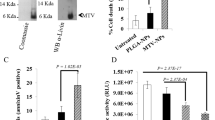Abstract
In human Burkitt's Lymphoma (BL) BRG cells, a t(8;14) translocation, placing c-myc near the Eμ enhancer of the H chain locus, causes tumor expansion. Earlier, we showed that a peptide nucleic acid complementary to the Eμ sequence (PNAEμ), specifically inhibited the expression of translocated c-myc and impaired the growth of BRG cells-induced subcutaneous tumors in mice suffering from severe combined immunodeficiency (SCID). In this study, the therapeutic potential of PNAEμ was evaluated in a systemic mouse model. BRG-BL cells transfected with the luciferase gene were inoculated intravenously into SCID mice resulting in a preferential expansion, similar to the one of human adult patients, in the abdominal cavity, central nervous system and bone marrow. The mice were chronically injected intraperitoneally either with PNAEμ or with control PNA. The treatment was stopped when the control animals developed severe neurological symptoms. As detected both by inspection at necropsy and imaging, overall tumor growth in PNAEμ-treated mice decreased by >80%. Histological and immunohistochemical studies showed, only in PNAEμ-treated mice, a substantially reduced BL cell growth at the major sites of invasion and vast areas of necrosis in the lymphomatous tissues, with concomitant c-myc expression downregulation. Altogether, the data support the therapeutic potential of PNAEμ in human adult BL.
This is a preview of subscription content, access via your institution
Access options
Subscribe to this journal
Receive 12 print issues and online access
$259.00 per year
only $21.58 per issue
Buy this article
- Purchase on Springer Link
- Instant access to full article PDF
Prices may be subject to local taxes which are calculated during checkout




Similar content being viewed by others
Accession codes
References
Kuppers R, Dalla-Favera R . Mechanisms of chromosomal translocations in B-cell lymphomas. Oncogene 2001; 20: 5580–5594.
Croce CM . Oncogenes and cancer. N Engl J Med 2008; 358: 502–511.
Lombardi L, Newcomb EW, Dalla-Favera R . Pathogenesis of Burkitt's lymphoma: expression of an activated c-myc oncogene causes the tumorigenic conversion of EBV-infected human B lymphoblasts. Cell 1987; 49: 161–170.
Polack A, Hörtnagel K, Pajic A, Christoph B, Baier B, Falk M et al. c-myc activation renders proliferation of Epstein-Barr virus (EBV)-transformed cells independent of EBV nuclear antigen 2 and latent membrane protein 1. Proc Natl Acad Sci USA 1996; 93: 10411–10416.
Cutrona G, Ulivi M, Fais F, Roncella S, Ferrarini M . Transfection of the c-myc oncogene into normal Epstein-Barr virus-harboring B cells results in new phenotypic and functional features resembling those of Burkitt's lymphoma cells and normal centroblasts. J Exp Med 1995; 181: 699–711.
Cutrona G, Carpaneto EM, Ponzanelli A, Ulivi M, Millo E, Scarfì S et al. Inhibition of the translocated c-myc in Burkitt's lymphoma by a PNA complementary to the Eμ enhancer. Cancer Res 2003; 63: 6144–6148.
Boffa LC, Cutrona G, Cilli M, Matis S, Damonte G, Mariani MR et al. Inhibition of Burkitt's lymphoma cells growth in SCID mice by a PNA specific for a regulatory sequence of the translocated c-myc. Cancer Gene Ther 2007; 14: 220–226.
Nielsen PE . Peptide nucleic acid targeting of double-stranded DNA. Methods Enzymol 2001; 340: 329–340.
Kilk K, Langel U . Cellular delivery of peptide nucleic acid by cell-penetrating peptides. Methods Mol Biol 2005; 298: 131–141.
Cutrona G, Carpaneto EM, Ulivi M, Roncella S, Landt O, Ferrarini M et al. Effects in live cells of a c-myc anti-gene PNA linked to a nuclear localization signal. Nat Biotechnol 2000; 18: 300–303.
Boffa LC, Cutrona G, Cilli M, Mariani MR, Matis S, Pastorino M et al. Therapeutically promising PNA complementary to a regulatory sequence for c-myc: pharmacokinetics in an animal model of human Burkitt's Lymphoma. Oligonucleotides 2005; 15: 85–93.
Blum KA, Lozanski G, Byrd JC . Adult Burkitt leukemia and lymphoma. Blood 2006; 104: 3009–3020.
Seam P, Juweid ME, Cheson BD . The role of FDG-PET scans in patients with lymphoma. Blood 2007; 110: 3507–3516.
Finer MH, Dull TJ, Qin L, Farson D, Roberts MR . kat: a high-efficiency retroviral transduction system for primary human T lymphocytes. Blood 1994; 83: 43–50.
Jenkins DE, Oei Y, Hornig YS, Purchio T, Contag PR . Bioluminescent imaging (BLI) to improve and refine traditional murine models of tumor growth and metastasis. Clin Exp Metastasis 2003; 20: 733–744.
Browne P, Petrosyan K, Hernandez A, Chan JA . The B-cell transcription factors BSAP, Oct-2, and BOB.1 and the pan-B-cell markers CD20, CD22, and CD79a are useful in the differential diagnosis of classic Hodgkin lymphoma. Am J Clin Pathol 2003; 120: 767–777.
Cattoretti G, Becker MH, Key G, Duchrow M, Schluter C, Galle J et al. Monoclonal antibodies against recombinant parts of the Ki-67 antigen (MIB1 and MIB3) detect proliferating cells in microwave-processed formalin-fixed paraffin sections. J Pathol 1992; 168: 357–363.
Acknowledgements
This work was supported by grants from the Associazione Italiana per la Ricerca sul Cancro (MF); FIRB RBIP06LCA9 (MF); ‘Rare Diseases’ Italy- USA 2006, N 526D/18 (GC); Associazione Italiana Leucemie (AIL), and Sez. Francesca Lanzone, SP (SR), Compagnia San Paolo (MC); SM was supported by a fellowship from the Fondazione Italiana per la Ricerca sul Cancro (FIRC).
We thank Ms Patrizia Mosca for technical assistance in performing the immunohistochemistry and Mr Alessandro Paganelli for the histological analysis. We are indebted to Dr Jennifer McMermott for the critical revision of the manuscript and to Dr Claudia Bolognesi for the statistical analysis.
Author information
Authors and Affiliations
Corresponding author
Rights and permissions
About this article
Cite this article
Matis, S., Mariani, M., Cutrona, G. et al. PNAEμ can significantly reduce Burkitt's lymphoma tumor burden in a SCID mice model: cells dissemination similar to the human disease. Cancer Gene Ther 16, 786–793 (2009). https://doi.org/10.1038/cgt.2009.26
Received:
Revised:
Accepted:
Published:
Issue Date:
DOI: https://doi.org/10.1038/cgt.2009.26



